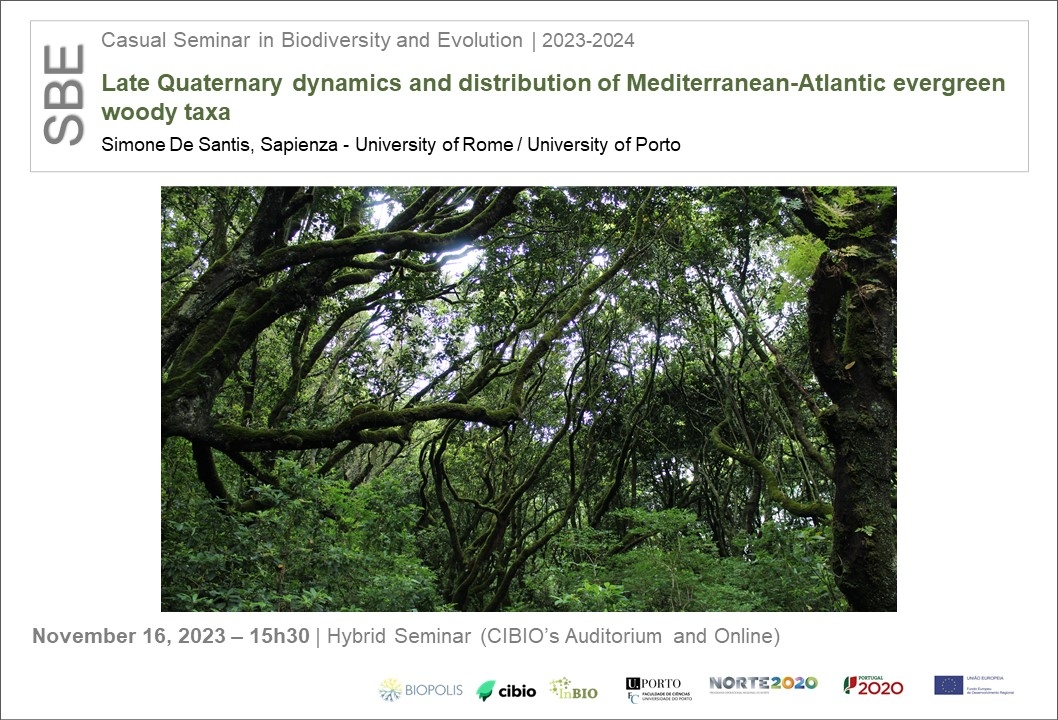Late Quaternary dynamics and distribution of Mediterranean-Atlantic evergreen woody taxa
Event
CASUAL SEMINAR IN BIODIVERSITY AND EVOLUTION
November 16th, 2023
Simone De Santis, Sapienza - University of Rome / University of Porto | 15h30 | Hybrid Seminar

CASUAL SEMINAR IN BIODIVERSITY AND EVOLUTION
In the West Paleartic region, four species of Arbutus and five species of Ilex are recorded according to the current outputs of phylogeny and taxonomy. They are centered in the Mediterranean-Atlantic Basin, scattered along the Atlantic coast, and reaching the Macaronesian Sub-Region, as two of the most important representatives of the Mediterranean-Atlantic broadleaved evergreen forest and thicket species. The aim of this project is to link the present and past distributions of the two Paleartic genera and provide a reliable reconstruction of plant history and population dynamics across the late Quaternary period.
The present-day distribution, obtained from floristic databases, herbaria collections, phytosociological surveys, literature, and personal observations, will be expressed as an occurrence-based map. Range maps for the past distribution of the two genera will be produced for the last 30 ka at 1000-year intervals. Fossil pollen records from palaeoecological databases will be checked to include only well-dated sites. They will be complemented by an extensive literature search from the whole study area to reach a minimum of 1000 fossil records. Ecological niche modelling and species distribution modelling will be performed to detect environmental drivers that constrain the geographical range.
The interconnection of occurrence records with the results from other biogeographical fields of research, such as palaeobotany, and ecological modelling holds great scientific promise. The comparison of detailed palaeodistribution maps and density-weighted ecological models is expected to clarify paradigmatic biogeographical questions, including the relation between current centers of gravity and glacial refugia, modern demography and postglacial population dynamics, and the nativeness of marginal populations versus human introduction.
In my bachelor's degree (Natural Science), I approached geobotany topics, especially the distribution of the Balkan/Eastern floristic element in the Italian Peninsula. Later in my master's degree, I focused on the Lusitanian floristic element in Europe, combining paleobotanical remains with phytogeographical data. The thesis was carried out under the co-tutoring of the Sapienza University of Rome and the University of Uppsala, where I stayed in 2020/2021 thanks to international scholarships. During the first two years of the PhD program at the Sapienza University of Rome, I attended several courses, seminars, and conferences (European Paleobotany and Palynology Congress 2022; Congress for Young Botanists 2023; European Vegetation Survey 2023; International Union for Quaternary Science Conference 2023), publishing contributions in the book of abstracts as well as a paper in an international journal. Currently, I'm involved in a co-tutoring program with the University of Porto, where I'm training to combine the use of paleobotanical and phytogeographical data with species distribution modeling and geo-statistics techniques.
[Host: Carlos Vila-Viçosa, Predicting and Managing Ecological Change - ECOCHANGE]
